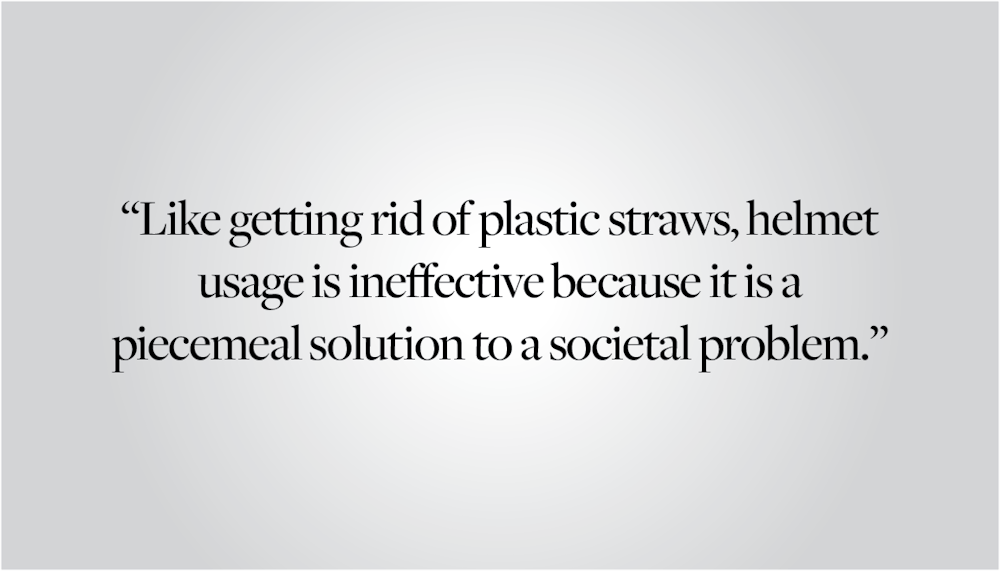In 2018, the World Wildlife Fund claimed that, by not using plastic straws, we could “help change the future for our oceans.” They were certainly addressing an important problem, but plastic straws constitute only a fraction of overall plastic pollution. The only viable way to mitigate plastic pollution is with international laws and policies that promote the reuse of plastic materials and production of new environmentally sustainable plastics. Though replacing plastic straws is a good first step, it is ultimately a band-aid solution for a large-scale problem. This brand of marketable “solutions” is all too common. Much like how nixing plastic straws sounds good but does little to address the scale of plastic pollution, bicycle helmets are easy to promote but do not really prevent cycling accidents or deaths at large. To actually make biking safer in the United States, we need societal and governmental changes.
To be clear, I am not against wearing a helmet when biking. Helmets have been found to reduce serious head injuries by 60% and face injuries by 23%. They make cyclists more visible to drivers, especially if your helmet is a bright color, and can protect from hazardous weather. Lab tests have reaffirmed the efficacy of helmets, at least in direct collisions with the top of one’s head and the ground.
Yet, on a societal level, helmet use does not correlate with reduced overall bike injuries. People often have to cycle in inherently dangerous environments like busy roads, where they face such a large risk that helmet usage only has a marginal impact on their safety. Paradoxically, roads and intersections can pose increased dangers for helmeted cyclists, as drivers tend to give less space to riders wearing helmets when overtaking them. Helmeted cyclists also tend to take more risks, likely because they feel safer, which offsets some of the benefits of wearing a helmet. Because of the many variables involved in car-cyclist collisions (the driver’s level of caution, the road surface, the car’s speed), some manufacturers do not technically even design helmets to mitigate the injury risks of getting hit by a car.
At a big-picture level, individual bikers should not be solely responsible for their safety when biking. Though they can take precautions by wearing a helmet and avoiding especially busy roads, they cannot control traffic, road conditions or the actions of others around them. Only a broader governing structure and a shift in our societal biking practices can do that. We should be grounding our bike safety strategies in a larger system that can protect everyone.
These safety mechanisms are far more effective than just helmet wearing. Designated bike lanes make cyclists safer, forcing drivers to respect cyclists’ place on the road. These lanes are especially effective when they have physical buffers like curbs or cones instead of just painted white lines. Beyond adding bike lanes, local and state governments should implement reduced speed limits in high-risk areas and add bike traffic lights. Cities can even build car-free zones into the grid and convert low-volume streets into bicycle boulevards.
Perhaps the best way to prevent cycling accidents is to encourage more people to cycle. Biking is much safer in large groups, since groups are easier for cars to spot and more difficult to speed past. Furthermore, drivers who also bike tend to be more respectful and safe when sharing the road because they understand how cyclists feel. This is why the Netherlands, which has more bikes than people, is one of the safest countries to bike in – even though it has a very low helmet-wearing rate. A counterintuitive but effective way to nudge more people to bike is to not mandate helmet use. Some view these mandates as an annoying deterrent to biking. Others even interpret them as a caution against cycling, given that few other leisure activities have government-mandated protective gear. Dallas and Tacoma have both repealed their mandatory helmet laws for this reason.
Like getting rid of plastic straws, helmet use is ineffective because it is a piecemeal solution to a societal problem. Without laws regulating plastic manufacturing and usage at a broad level, plastic pollution will continue to worsen; likewise, without increased road protections for all cyclists, they will continue to sustain road injuries too often No amount of helmet-wearing will change this — it should be seen as the last line of defense for a biker. To quote English barrister Sir Edward Coke: “Law is the safest helmet.” Instead of acting like a helmet is protection enough, we need to shield bikers from road accidents with concrete measures at the government level.
Benjamin Aizenberg ’26 can be reached at benjamin_aizenberg@brown.edu. Please send responses to this opinion to letters@browndailyherald.com and other op-eds to opinions@browndailyherald.com.





